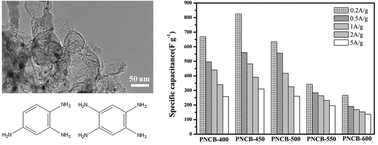Facile synthesis of porous carbon materials with extra high nitrogen content for supercapacitor electrodes†
Abstract
Herein, we report the facile synthesis of three-dimensional porous nitrogen-doped carbon materials (PNCs) with extra high nitrogen content by means of directly carbonizing nitrogen-enriched precursors, 1,2,4-benzenetriamine dihydrochloride (BTD) and 1,2,4,5-tetraaminobenzene (TAB) with the aid of FeCl3·6H2O. The influence of the carbonization temperature and selection of precursors on the morphologies and properties of PNCs were studied using scanning electron microscopy (SEM), Brunauer–Emmett–Teller (BET), X-ray diffraction (XRD), etc. Their electrochemical performance was characterized using galavanostatic charge–discharge (GCD), cyclic voltammetry (CV) and electrochemical impedance spectroscopy (EIS). A PNC obtained by carbonizing BTD at 450 °C exhibits a high nitrogen content (about 23.85 wt%), and large surface area (1335 m2 g−1). As a result, it shows a high specific capacitance of 482 F g−1 at a current density of 1 A g−1 in 1 M H2SO4 and excellent cycle stability, 98% retention after 12 000 cycles. Furthermore, a liquid sandwich-structured symmetric supercapacitor assembled from this PNC can power a light stopwatch for about 10 minutes, demonstrating that it is a promising material for supercapacitor electrodes.



 Please wait while we load your content...
Please wait while we load your content...